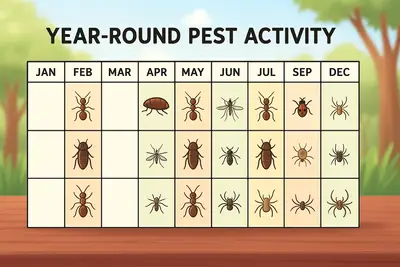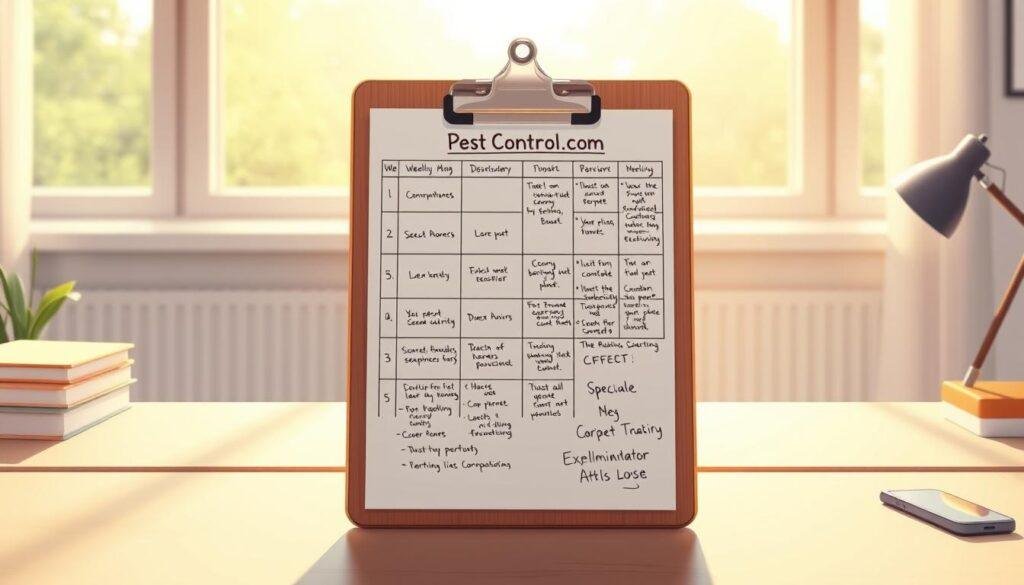
How Often Should You Schedule Pest Control Services?

Pest control services are essential for keeping unwanted animals out of your home. Scheduling regular treatments is one of the simplest ways to maintain a peaceful and safe environment. Consistency is key, as many household pests can pose health risks if left unchecked.
As the seasons change, different pests attempt to make your home theirs. That’s why having a consistent pest control plan is as important as your annual health checkup. Companies like Terminix offer seasonal pest protection plans to strengthen your home’s defenses, while Orkin provides scheduled services and rapid response if pests appear between visits. Even in colder months, rodents and cockroaches often seek warmth indoors—proving the need for year-round protection.
Is your home properly protected?
Checking out ExterminatorAtlas.com can be your starting point to adding pest control into your home care routine. This site offers many choices, like quarterly or yearly plans, tailored to your home’s specific needs, location, and climate. These factors all play a part in your pest control schedule.
- The Importance of Regular Pest Control
- Understanding Pest Control Frequency
- What Influences Your Pest Control Schedule?
- How often pest control service
- Benefits of a Quarterly Pest Control Plan
- Optimal Pest Treatment Frequency for Different Pests
- Annual vs. Quarterly Pest Control: Which is Best for You?
- Do You Need More Frequent Pest Control in Warmer Climates?
- Recognizing Signs You Need Immediate Pest Control
- Tips for Maintaining a Pest-Free Home Between Services
- Why Regular Pest Inspections are Crucial
- Conclusion
- FAQ
The Importance of Regular Pest Control
Having regular pest control is key for a healthy, safe home. It helps prevent unexpected bug problems. This keeps everyone in the house healthy.
Getting your house checked for pests regularly stops them from growing in number. It's smart to figure out how often to inspect your home. This way, you find pests early and deal with them quickly.
Preventing Infestations Before They Start
Starting pest control early is best to stop bugs before they show up. Making sure your home gets checked often makes a big difference. It lowers the chance of suddenly dealing with many pests.
Protecting Your Health and Home
Staying on top of pest control is also great for your health. It gets rid of bugs that can make you sick or trigger allergies. Plus, it keeps your house in good shape. This means no damage from critters that can lead to costly fixes.

Understanding Pest Control Frequency
Finding the best pest control frequency is key for effective pest protection. Experts, like those at Terminix, suggest services every quarter as the optimal pest treatment frequency. This timing works well with the seasonal nature of pests.

This plan keeps your home safe all year, including the cold months. That's when pests like cockroaches and mice might come indoors. Changing your pest control with the seasons can manage pests well and be eco-friendly.
Having a year-round barrier against pests is the goal. The quarterly pest control frequency is popular for this reason. Companies provide reports showing when pests are most active, helping plan the best treatment times. Acting early on these tips can stop infestations from getting bad.
Using the optimal pest treatment frequency and green methods is best. It keeps your home safe from pests and cares for the environment too.
What Influences Your Pest Control Schedule?
Determining how often to do pest control involves many factors. Knowing what affects pest control helps keep your place pest-free.
Type of Pest
Each pest behaves differently and has unique lifecycles. For instance, termites swarm in certain seasons. So, it's important to customize your pest control methods and timing.
Seasonal Pest Behavior
Pests are more active in certain seasons. For example, bugs increase in warm months, while rodents look for warm places when it's cold. Knowing these patterns helps in planning effective pest control.
Your Home’s Location and Environment
Where your home is located can affect pest problems. Homes near woods might get more ants or ticks. Therefore, it's key to consider your environment when setting up pest control plans.

- Inspecting your home routinely to identify any potential risks or existing problems.
- Ensuring that pest control schedules are matched with the life cycles and peak activity periods of common pests.
- Adjusting methods and frequency of treatments based on seasons and environmental conditions.
By considering these factors, you can make a pest control plan that stops infestations before they start. This approach keeps your home safer and pest-free all year.
How often pest control service
Choosing the right pest control service frequency depends on the local weather and pest types around you. It's key to have a regular pest control program to keep your home safe and healthy for everyone who lives there.
In warm places like Florida, pests are more active year-round, meaning more pest control is needed. But in cooler areas, you might not need pest control as often. Your pest control plan should include regular visits and emergency services for the best protection.
Here's a simple guide for how often to get pest control:
- Quarterly visits work well for common bugs such as ants, spiders, and roaches.
- Annual checks are suggested for termites, with treatments based on the building's past and risk levels.
- Monthly services might be needed for places with lots of pests or big infestations.
The main aim is to stop pests before they become a problem, keeping your living space safe and healthy. Matching the pest control service frequency to your home's specific needs offers the most efficient and cost-effective way to do this.
Benefits of a Quarterly Pest Control Plan
To protect your home all year, you need a routine pest control plan. A quarterly plan is best as it matches pest breeding times. This includes pests like ants, spiders, and rodents.
Choosing a quarterly pest control service brings many benefits. It keeps your pest defense strong and regular. Companies like Lloyd Pest Control handle many pests, including roaches and rodents, using green solutions.
Each season brings different pests. So, a quarterly pest control plan is necessary. In spring, it may focus on ants. Summer might target flies and stinging bugs. And fall and winter focus on rodents looking for a warm place.
This plan also offers ongoing monitoring. Professionals visit regularly, treating current problems and spotting future risks. This helps stop infestations before they start. It saves you from stress and costly damage.
A quarterly pest control plan means acting before pests become a problem. It changes treatments with the seasons for year-round protection. This method keeps homes safe and follows expert advice.
Optimal Pest Treatment Frequency for Different Pests
It's very important to know when to check for pests and when to treat them. How often you need to treat for pests depends on which ones you have. Ants, spiders, and roaches usually need treatments every three months. This helps keep them away all year. Termites are tougher and need more serious treatment to stop them from coming back.
Lloyd Pest Control has a Termite Protection Plan which works every year. This plan stops termites from damaging your house. Knowing when pests are most active helps make pest control better. For those in Southern California, it's good to know that rodent and silverfish problems grow in the colder months. So, adjusting when you manage pests can really help.
| Pest Type | Suggested Inspection Interval | Recommended Treatment Frequency |
|---|---|---|
| Ants, Spiders, Roaches | Quarterly | Quarterly |
| Termites | Annually | Annual Checks and On-Demand Treatment |
| Rodents | Biannually | As needed during peak season |
| Silverfish | Annually | Seasonal Precautions (Cold Months) |
With careful timing of inspections and treatments, your home can be safe from pests. As weather changes, so do pest activities. Being ahead with your pest checks and treatments is the best way to keep them out.
Annual vs. Quarterly Pest Control: Which is Best for You?
Choosing the right pest control schedule is key for good pest prevention. Homeowners often wonder if it's better to have yearly or every three months for pest control. This choice affects both the cost and how well it works. It depends a lot on the kinds of pest problems you have.
Comparing Cost and Effectiveness
Pest control service frequency can change your costs a lot and how good each treatment is. Experts often suggest getting services every three months. This helps protect against many pests all the time. When looking at costs, homeowners notice that getting service every three months can save money over time.
However, choosing a yearly visit might not catch when pests are most active. This could lead to big infestations that are expensive to fix.
Assessing the Need Based on Pest Types
Some pests are more active at different times, which means you might need more frequent service. For example, places with lots of termites or mice might need more visits. Pest control should match your area and the pests you're dealing with. Services like Terminix offer free first inspections to help make a plan based on your home's size, location, and pest issues.
To pick the right service frequency, consider factors like local weather, your home's build, and which pests are a problem. Balancing these with cost and potential damage from pests will help you choose the best pest management for your home.
Do You Need More Frequent Pest Control in Warmer Climates?
In places where it's always warm, pests are always a problem. Experts in bugs say that in warm places, you might need to fight pests more often. This is really true in places like Southern California, where it's almost always breeding season for bugs.
Seeing a pest pro more often isn't just to stop bugs from bothering you. It's about keeping your home healthy. When it's warmer, pests can grow their families faster. This means stopping pests early is key to keeping your home safe.
| Factor | Impact on Pest Activity | Necessitated Service Frequency |
|---|---|---|
| Higher Temperatures | Increases pest metabolism and breeding rates | Monthly |
| Continuous Seasons | Pests remain active year-round | Bi-monthly |
| Mild Winters | Limited die-off of pest populations | Monthly or quarterly adjustments |
Choosing the right pest control service frequency means you can keep bugs under control. It makes your home safer and more comfy no matter the time of year. Pest prevention maintenance is about stopping pests before they start, not just fighting them when they appear.
Recognizing Signs You Need Immediate Pest Control
Understanding when you need fast pest control is key for a safe, comfy home. It's important to stay alert for signs that you need expert help right away. Catching these signs early helps avoid big damage and keeps everyone healthy and safe.
Seeing bugs like cockroaches, ants, or mice more often is a red flag. It means your pest control might not be working well. Also, if pests are more active between your regular pest control visits, take notice. Look out for new nesting signs, damaged food packages, or odd sounds in walls at night.
Most pest control plans allow you to call for help any time because quick action is crucial. Don’t wait for your next scheduled appointment; call your pest expert right away. Acting fast is especially critical for pests that threaten your health or can quickly damage your home.
The aim is not just to fix pest issues but to prevent them before they worsen. If you notice any of these signs, it could mean the problem may get bigger without quick, effective treatment. Taking quick steps helps protect your property, your health, and your loved ones.
Tips for Maintaining a Pest-Free Home Between Services
Keeping your home free of pests is key for staying comfortable and healthy. There are things you can do between professional pest control visits to help. Doing regular tasks to prevent pests can greatly reduce the chance of getting an infestation.
Start by taking care of the outside of your home. Keep thick plants and wood piles far from your home's base to prevent pests from making it their home. Also, make sure your screens and weather stripping are in good shape to stop pests from getting inside.
Inside your home, keeping things clean is very important. You should seal food tightly and clean up messes right away. Use plastic containers instead of cardboard to keep bugs like cockroaches and rodents away. Also, make sure trash cans are clean and away from doors to help keep pests out.
- Trim any plants that are too close to your home.
- Check and fix any damage to screens and weather stripping often.
- Keep your food in containers that seal tightly.
- Fix leaks quickly so you don't attract ants and roaches.
Following these steps will help cut down on the need for pest control services. This means a healthier home without pests.
Why Regular Pest Inspections are Crucial
Regular pest inspections keep your living space safe and healthy. By choosing the right pest inspection interval and pest management timing, you stop pests before they get worse. These checks spot entry points and catch infestations early.
Finding the best pest inspection interval and pest management timing depends on your home and local pests. For houses that had pests before, setting up a yearly termite plan is key.
Identifying Potential Entry Points
Inspectors look for cracks and holes that pests might use to get inside. They work to block these spots, keeping pests out. This helps stop issues before they start.
Early Detection of Pest Problems
Spotting pest signs early lets experts handle small issues quickly. By getting the pest inspection interval and pest management timing right, treatments are more effective. This protects your home against pests in the future.
Conclusion
Finding the optimal pest treatment frequency is key to protecting your home and health from unwanted pests. Regular pest control, often done quarterly or yearly, helps stop infestations and keeps your living area safe. The type of pests, where you live, and the local weather can affect how often you need pest control.
It's also smart to be proactive between professional visits. Take steps to prevent pests and watch for any signs of them. It's not just about the visits from the pros. The effort you put into keeping pests out is just as crucial.
So, the aim is to find the right mix of professional help and doing things on your own to prevent pests. Regular pest control plus staying vigilant at home builds a strong defense against pests. In a home that's well-protected, the value of a good pest control plan is clear. It leads to a peaceful, pest-free living space.
FAQ
How often should you schedule pest control services?
Why is regular pest control important?
What factors influence the frequency of pest control?
How does the type of pest affect my pest control schedule?
What seasonal pest behaviors should I be aware of?
How does my home's location and environment affect my pest control needs?
What are the benefits of a quarterly pest control plan?
What is the optimal pest treatment frequency for different pests?
Should I consider annual or quarterly pest control services?
Do warmer climates require more frequent pest control?
How can I recognize signs that I need immediate pest control?
What preventive measures can I take to maintain a pest-free home between services?
Why are regular pest inspections crucial?
How can I identify potential entry points for pests during inspections?
What does early detection of pest problems involve?
Whether you’re tackling a single rogue ant or battling a full-scale termite invasion, our guide has you covered. Save How Often Should You Schedule Pest Control Services? to your bookmarks and visit often—we refresh tips, treatment methods, and product reviews throughout 2025 so you can keep every pest problem under control the moment it appears.

Leave a Reply